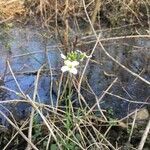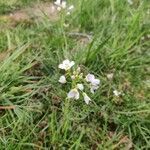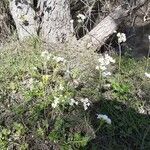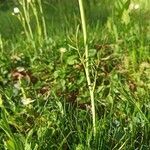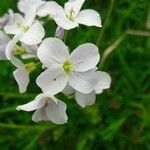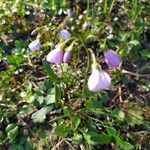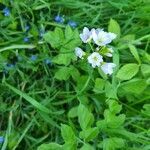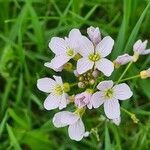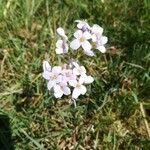Herbs perennial, (8-)15-55(-80) cm tall, glabrous or rarely sparsely pilose basally. Rhizomes tuberous, to 5 mm in diam., without stolons. Stems erect, simple, 2-12(-18)-leaved. Rhizomal leaves to 30 cm; petiole (1-)2-7(-10) cm; terminal leaflet orbicular or broadly obovate, 0.3-2 cm in diam., with a petiolule to 1.5 cm, base rounded, rarely subreniform or cuneate, margin repand, apex rounded; lateral leaflets (0 or)2-8(-15) on each side of rachis, about as large as or smaller than terminal leaflet, orbicular, ovate, or obovate, petiolulate or sessile, margin crenate or repand. Cauline leaves including petiole 2-17 cm, pinnatisect, glabrous; petiole base not auriculate; terminal lobe linear, oblong, ovate, or lanceolate, 1-2.5(-3.5) cm × 5-8(-10) mm, petiolulate or sessile; lateral lobes 4-7(-13) on each side of rachis, similar to terminal lobe, base petiolulate or sessile and decurrent, margin entire or rarely dentate. Fruiting pedicels erect-ascending or subdivaricate, (0.5-)1.2-2.5(-3) cm, slender. Sepals oblong or ovate, (2.5-)3-5(-6) × 1-2 mm, erect or spreading, base saccate, margin membranous. Petals purple or lilac, rarely white, obovate, (0.6-)0.8-1.5(-1.8) cm × 3-7.5(-10) mm, clawed, apex rounded or emarginate. Median filament pairs 5-10 mm, lateral pair 3-6 mm; anthers narrowly oblong, (0.8-)1.2-2 mm. Ovules 20-30 per ovary. Fruit linear, (1.6-)2.5-4.5(-5) cm × (1.2-)1.5-2.3 mm; valves glabrous; style (0.5-)1-2.2(-2.7) mm, stout. Seeds light brown, oblong, 1.2-1.8(-2) × 1-1.4 mm. Fl. May-Jul, fr. Jun-Aug. 2n = 16, 24, 28-34, 38-44, 48, 56, 96.
Perennial herb. Rhizomes present. Stems erect, straight, glabrous, purplish or green, (15)-30-60-(80) cm tall. Lvs thin, green, glabrous, or rarely cauline lvs ciliate. Basal lvs many, pinnate, petiolate; terminal leaflet broadly elliptic, entire, lobed or toothed, shallowly cordate, larger than laterals; lateral leaflets in (3)-4-5-(6) pairs, broadly ovate, lobed or entire, shallowly cordate at base; petiolules < leaflets. Cauline lvs pinnate, shortly petiolate; terminal leaflet larger than laterals, entire, becoming narrow-elliptic to linear, cuneate at base; lateral leaflets in (3)-4-5-(6) pairs, entire, narrow-obovate to linear, cuneate at base, subsessile. Infl. racemose, straight, glabrous, 15-35 cm long. Pedicels glabrous, erecto-patent, 10-20-(30) mm long at fruiting. Sepals glabrous, green or pinkish, with scarious margins, 2.5-4 × 1-1.5-(2) mm. Petals pink, spreading, clawed, 8-11 × 4-6 mm. Stamens 6. Silique pale yellowish green or with purple valves, erect, (10)-15-18-(25) × 1-1.5 mm; valves glabrous; style 1-2 mm long. Seeds reddish brown, elliptic-oblong, not winged, c. 1.5 mm long.
Erect perennial 2–5 dm; basal lvs long-petioled, with 3–8 broadly oval to rotund or reniform lfls 5–20 mm, the terminal the largest; lowest cauline lvs sometimes like the basal, the others all shorter, on shorter petioles, the mostly 7–17 lfls oval to oblong or linear; fls crowded, the pet obovate, 8–15 mm; mature pedicels ascending, 8–15 mm; frs suberect, 2.5–4 cm, the beak 1–2 mm; 2n=16–96. Circumboreal, with 2 vars. in our range. Var. pratensis, a native of Eurasia, is intr. in moist soil of roadsides, lawns, and meadows from Nf. to N.Y. and N.J.; it has pink fls, the terminal lfl of the basal lvs is angularly dentate, and the lateral lfls of the cauline lvs tend to be sessile; 2n=<56. Apr.–July. Var. palustris Wimm. & Graebn. is native in bogs and swamps throughout most of Can., extending s. to N.J., O., n. Ind., and Minn.; it has white fls, the terminal lfl of the basal lvs is entire or nearly so, and the lateral lfls of the cauline lvs are commonly contracted to a short petiole; 2n=>56. May, June. (C. palustris)
A cabbage family herb that keeps growing from year to year. It grows up to 55 cm tall. It is like Common bittercress but larger. The stems are smooth, straight and hollow. The leaves are cress like. They are compound and occur in rings near the base. The leaves at the base have long leaf stalks. The leaves on the stem have sort stalks and are more narrow. The flowers are pink and white. They are 1.2-2 cm wide. They have 4 petals. They are in dense clusters at the top of the plant. The fruit are long pods. They open by spirally coiled valves.
